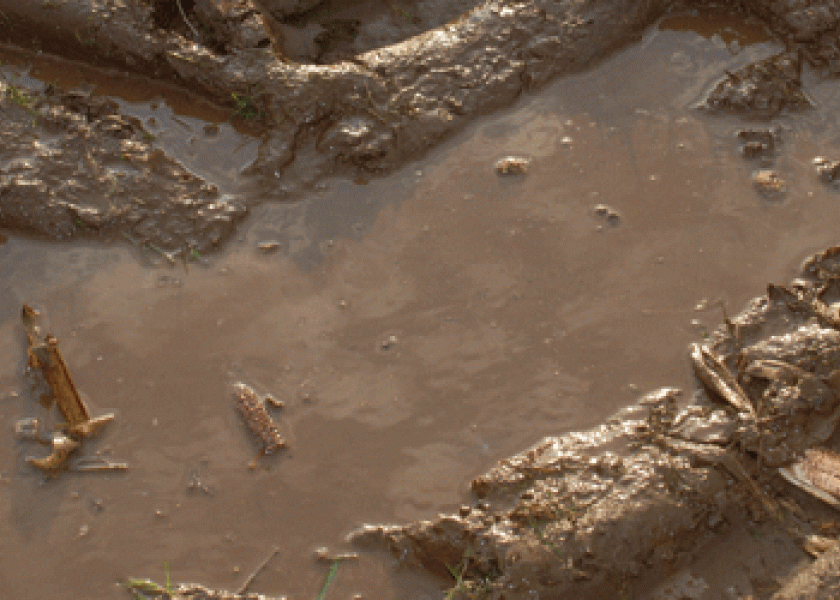8 Soybean Planting Reminders for When Mother Nature Doesn’t Cooperate

Plant early for optimum yield is a common refrain soybean growers hear from agronomists and other crop production experts today. But when Mother Nature doesn't cooperate, you might have to regroup.
Here are eight things to consider now that the early soybean planting window is closing.
1. Be ready to go. If it looks like your planting season is going to be a series of starts and stops this year, try to get ready and stay ready. That means readying equipment, seed and other inputs, so you can go to the field whenever conditions allow.
Side note: Make sure your planter is set to do a good job of singulating because you’ll likely get a more uniform pod load, which is important to yield.
2. Consider the weather conditions and expected emergence date. Roll planters into fields when soil temperatures are at least 50 ˚F and the weather forecast is favorable, says Shawn Conley, soybean and small grain specialist at the University of Wisconsin-Madison.
He says while planting date is important to soybean production, the driver is emergence date.
“If you planted on April 10 and April 23 and both plantings emerged on May 2, don’t expect a yield response to planting date,” he says in a tweet.
3. Plant when soil conditions are good. Muddying in a crop can set you back instead of moving you forward.
“Just a friendly reminder you can get sidewall compaction with soybeans just as easily as you can when you plant corn,” Conley says. (Check out Conley's presentation, Starting Out the 2022 Soybean Growing Season on the Right Node, on YouTube youtu.be/CxGbC8YBp2M .)
Use the ribbon test to check soil conditions in fields. Here are the three basic steps:
1. If you typically run a tillage tool 4” deep, dig down under that to about 5” deep.
2. Collect some soil in your hand and attempt to ball it up.
3. Once you get it balled up, squeeze it between your thumb and forefinger to see if you can make a ribbon about 1½” long.
“If you can make a ribbon, your tillage will not only put in a density change, but it will also put in a compaction layer,” says Ken Ferrie, Farm Journal Field Agronomist. “If you decide to move forward with tillage and planting, you probably will need to adjust your yield expectations later in the season as well as your marketing plan.”
4. Consider your row spacing. Planting in early May will result in higher yields than planting in late May or June regardless of row spacing. However, “narrow rows are even more advantageous in late-planting situations because they are able to capture available sunlight more quickly,” according to Mark Licht, Extension cropping systems specialist with Iowa State University.
5. Evaluate disease risks. Diseases such as brown stem rot and soybean cyst nematode can be a problem if you plant more susceptible varieties in narrow rows, says Brad Daughtery, a farmer and district director for Illinois Soybean Association.
If white mold is an issue, talk with your agronomist or retailer about whether going with narrow rows is a fit for your fields. Wide rows (≥30”) are still considered a management tool under severe white mold pressure.
6. A mix of maturity groups is good. “To avoid having all your soybeans caught by the same adverse weather, mix up maturity groups,” Ferrie says. “That way you won’t have all your soybeans at the R2 reproductive stage at the same time or ripe at the same time. It also avoids soybeans popping out of the pod because you can’t combine them soon enough.”
“Planting 30% early soybean varieties, 50% mid-season maturity and 20% late-season will mitigate risk from rain or hail in the summer,” Ferrie says. “It also gets harvest started sooner and prevents all your soybeans from ripening at the same time.”
7. Consider investing in potassium (K). “There is a relationship between low fertility values and the onset of disease and insect pressure,” Conley says. “Consider maintaining your K, even if it’s a bit more than you want to spend, especially if it’s on your own land.”
8. Stay with the crop. If you do have to plant in tough conditions and get a less than ideal stand, don’t give up on the crop — soybeans have a remarkable ability to compensate.
“Because soybeans set their yield later in their development, a tough start for beans doesn’t carry the yield penalty that it does for corn,” Ferrie points out.
Ferrie: Muddying Corn Into Fields? That Can Cost You 30 Bushels Per Acre
Rally Your Team: 7 Tips to Maximize Hours and Reduce Stress During Planting







